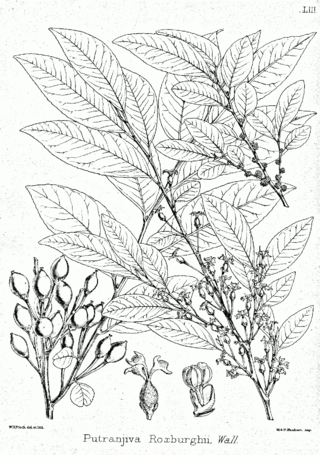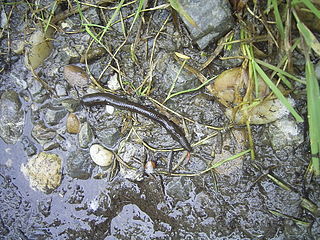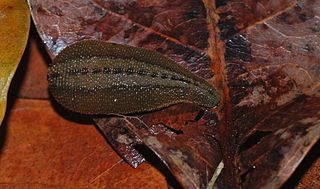
Pinus sylvestris, the Scots pine (UK), Scotch pine (US) or Baltic pine, is a species of tree in the pine family Pinaceae that is native to Eurasia. It can readily be identified by its combination of fairly short, blue-green leaves and orange-red bark.

Putranjiva is a plant genus of the family Putranjivaceae, first described as a genus in 1826. It is native to Southeast Asia, the Indian Subcontinent, Japan, southern China, and New Guinea.

Haemadipsidae are a family of jawed leeches. They are a monophyletic group of hirudiniform proboscisless leeches. These leeches have five pairs of eyes, with the last two separated by two eyeless segments. The family is monotypic, containing only the subfamily Haemadipsinae, though as the family can apparently be divided into two or three distinct lineages, at least one of the proposed splits, while not a distinct family, might be a valid subfamily.

Ruellia is a genus of flowering plants commonly known as ruellias or wild petunias. They are not closely related to petunias (Petunia) although both genera belong to the same euasterid clade. The genus was named in honor of Jean Ruelle (1474–1537), herbalist and physician to Francis I of France and translator of several works of Dioscorides.
John Percy Moore (1869–1965) was an American zoologist who specialized in the research of leeches.

Arhynchobdellida, the proboscisless leeches, are a monophyletic order of leeches. They are defined by the lack of the protrusible proboscis that defines their sister taxon, the Rhynchobdellida. Arhynchobdellida is a diverse order, comprimising both aquatic and terrestrial, besides sanguivorous and predatory, leeches. The order is divided into two suborders, Erpobdelliformes and Hirudiniformes.

The Hirudiniformes are one of the currently-accepted suborders of the proboscisless leeches (Arhynchobdellida). Their best-known member is the European medical leech, Hirudo medicinalis, and indeed most of the blood-sucking "worms" as which leeches are generally perceived belong to this group. In general, though some leeches suck blood, many are predators which hunt small invertebrates.

Leeches are segmented parasitic or predatory worms that comprise the subclass Hirudinea within the phylum Annelida. They are closely related to the oligochaetes, which include the earthworm, and like them have soft, muscular segmented bodies that can lengthen and contract. Both groups are hermaphrodites and have a clitellum, but leeches typically differ from the oligochaetes in having suckers at both ends and in having ring markings that do not correspond with their internal segmentation. The body is muscular and relatively solid, and the coelom, the spacious body cavity found in other annelids, is reduced to small channels.

Kokoona zeylanica, known in Sinhala as කොකුන් (Kokun) is a species of plant in the family Celastraceae. It is not to be confused with the similar sounding word කොකුම් which stands for the Kokum plant. The genus was formerly classified in the family Hippocrateaceae.

In molecular biology, haemadin is an anticoagulant peptide synthesised by the Indian leech, Haemadipsa sylvestris. It adopts a secondary structure consisting of five short beta-strands (beta1-beta5), which are arranged in two antiparallel distorted sheets formed by strands beta1-beta4-beta5 and beta2-beta3 facing each other. This beta-sandwich is stabilised by six enclosed cysteines arranged in a [1-2, 3-5, 4-6] disulfide pairing resulting in a disulfide-rich hydrophobic core that is largely inaccessible to bulk solvent. The close proximity of disulfide bonds [3-5] and [4-6] organises haemadin into four distinct loops. The N-terminal segment of this domain binds to the active site of thrombin, inhibiting it.

Hydrolea is the only genus of the family Hydroleaceae of the order Solanales.

Smilax zeylanica is a plant species in the genus Smilax. Its leaves and roots are used for medicinal purposes. The plant is widespread in India, and native in other parts of the Indian Subcontinent as well as in Myanmar, Malaysia, Java and Solomon Islands. It is traditionally used for the treatment of ulcers. It is one of the larval host plants of the butterfly Zesius chrysomallus.

Haemadipsa picta is a large terrestrial leech found in Borneo, Indochina, and Taiwan. It was described by John Percy Moore based on specimens collected from Sarawak, Borneo. It preys primarily on medium- to large-sized mammals, including humans.

Elaeocarpus sylvestris, the woodland elaeocarpus, is a tree species in the genus Elaeocarpus.

Neope is a genus of butterflies of the family Nymphalidae found in Asia.

Aphantopus is a butterfly genus of the Satyrinae. The genus is confined to the Palearctic.

Haemadipsa interrupta is a hermatophagous terrestrial leech found in the Malay Peninsula. It was described by John Percy Moore.
Sinospelaeobdella is a genus of jawed land leech, endemic to caves in China. It contains the species S. cavatuses and S. wulingensis, the latter being named after the Wuling Mountains where it was found.
Haemadipsa sylvestris is a species of blood-feeding leech recorded from India, Nepal, Sri Lanka, Myanmar, Malaysia, and Indonesia. A species of freshwater crab, Himalayapotamon atkinsonianum, has been recorded as a host. The species is known to grow as large as 40 mm in length and 7 mm wide. It is a lowland species, and closely associated with water; it lives near riverbanks and ponds, and may sometimes be flooded out in some regions.
Tritetrabdella is a genus of terrestrial hemataphagous leeches in the family Haemadipsidae. Unlike other haemadipsid leeches, Tritetrabdella species have four annuli on their mid-body segments. They have three jaws, with a total 45 teeth, and lack salivary papillae. Tritrabdella feeds primarily on amphibians and probably on small mammals as well, but to a lesser extent. Bornean species may be endangered due to amphibian population decline, disturbance and fragmentation of habitat, and climate fluctuations.
















